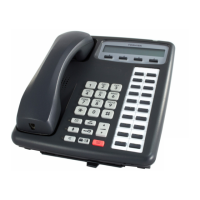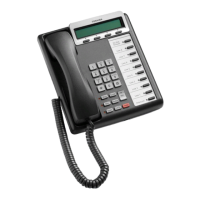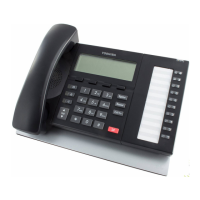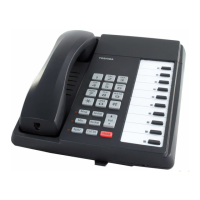DK40 Installation
TBSU Two-circuit ISDN BRI Interface Unit
2-46
Strata DK40 I&M Manual Spring 1999
Refer to the Strata DK40 Programming Manual or DK Library CD-Rom for more details.
considerations. All connections should be installed in accordance with BS EN 50098-1: 1994
(or the latest issue).
To control electrical characteristics, a 100-ohm terminating resistor (TR) is required at both
ends of the passive bus. One resistor should be across the Tx pair and one across the Rx pair
at either end of the passive bus.
The TBSU circuits provide an option switch that allows the 100-ohm TR to be switched into
the circuit on the DK side of the bus (See Table 2-9 on Page 2-39). Most TE and TA devices
also provide option switches to connect 100-ohm terminating resistors as shown in Figure 2-
23.
If the TE or TA devices do not provide TRs, they may be permanently wired in place on a RJ-
45 jack at the far end of the bus. Only one terminating resistor on each pair should be on the
far (TE) end of the passive bus - do not switch in TRs on more than one TE or TA device on
the passive bus.
Note
The correct placement of TRs on the passive bus is critical to ISDN BRI circuit
operation (see TBSU “NT” Mode Facilities below).
TBSU “NT” Mode Facilities
The NT function has been designed to conform to the ETSI ISDN standards. It is designed to
operate only in “Point-to-Multipoint” mode and will support ISDN terminal equipment that is
of the Automatic TEI type.
Bearer Service Handling
For any internal call, generated by an ISDN TE, the NT function will only accept a Bearer
Service request for Speech or 3.1kHz if the destination point is a Digital or Electronic Key
Telephone, or a standard telephone/device. If the destination port is another NT port or an
outgoing call the requested Bearer Service will be transparently passed through and it is the
responsibility of the terminating ISDN TE to accept or reject the call.
Supplementary Services
The following supplementary services are supported:
◆ CLIP - Calling Line Presentation
◆ COLP - Connected Line Presentation
◆ DDI - Direct Dialling In
◆ SUB - Sub Addressing sending and receiving
Note
If the DK40 system receives Sub-Address information it is transparently passed onto
the NT type ports or ignored if the call destination is a Digital or Electronic Key
Telephone, or a standard telephone/device.
TBSU BRI Call Monitor
The call-monitor jack located on the TBSU enables you to use a PC or ASCII terminal to
monitor the BRI, D-channel call setup, layer-2 and layer-3 data. Figures 2-25 and 2-26
provide examples of BRI call setup message information that is available from the TBSU
call-monitor jack.

